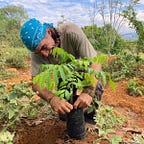The Connective Intelligence of Life
There’s been a lot of talk in recent years about “collective” intelligence — how networks of people can swarm together in social movements to make sense of the world and act upon it appropriately. I want to suggest that it might just be better to describe phenomena like this as connective intelligence instead.
All living things are enmeshed in dynamic processes of feedback, regeneration and decay. They continually exchange chemicals and energy with their environments. Try to find a boundary anywhere in the system and you’ll quickly realize that no actual boundaries exist, everything is interconnected.
How can this insight be applied to the convergence of global crises humanity is now confronting? First off, we can name the confusion around “issues” that claim global warming to be separate from violence against women; wealth inequality separate from extreme opulence; police brutality separate from systems of marginalization and oppression; and so on. All of these things are connected.
Yet our minds are conditioned to treat them as separate entities.
This is extremely important. We need to realize that the illusion of separation is what keeps us from behaving collectively in an intelligent manner. When we act upon the world as if it were a collection of individualized entities — rational “actors” in markets, rogue “agents” in moments of violence; singular “viruses” during a health epidemic; and so forth — it is our mental constructs that keep us from seeing the systemic point-of-view that makes root causes visible to us.
Thus we do not act with intelligence because our conceptions about the world presume disconnection, while in reality it is the interconnections that matter.
A powerful way to learn how connective intelligence works is to think about a multicellular organism like the human body. The body is made up of trillions of cells. According to this estimate, 37.2 trillion… that’s a LOT of cells! From moment to moment, this vast array of tiny entities is engaged in a cosmic dance of interactions and exchanges. To be alive is to be a dynamic pattern of continual exchange within and throughout the environment. Oxygen must be delivered simultaneously to cells in your brain, your liver and kidneys, and the skin at the end of your toes.
An amazing feature of all living things is that they are capable of sense-making and taking purposeful actions to continue their existence. This is true for single-celled creatures like paramecium who can detect chemical gradients and follow them to food sources. It is equally true for the human body that uses its central nervous system to create “neural maps” of its holistic condition to track things like blood pressure, levels of different hormones, tension in muscles, and information gathered through sensory pathways like vision, touch, and hearing.
The brain acts as a synthesizer to help the body coordinate itself so that it remains within safe operating parameters. Keep the brain cooled enough that it doesn’t damage its tissue. Hold the acidity within a range that keeps the stomach from digesting itself. Manage pressure in the arteries so that the heart does not get torn or weakened. This gestalt process is called homeostasis and it is a fundamental governance feature of all living things.
The intelligence of homeostasis cannot be found in the brain alone. It is only knowable by looking at all the connections throughout the body. Circulatory systems carry oxygen and trace hormones to every organ, every limb. Lymphatic systems monitor hormone levels and regulate glands to link up circulation with cognition. Digestive systems track nutrient levels and signal the glands to alter circulation and impact the overall behaviors of the body so that it seeks food or quenches thirst.
The intelligence of life is only possible because everything is interconnected.
The connectedness is what gives rise to the emergence of intelligent behavior. Apply this to chronic problems in the world and you’ll see how the linkages existing between media and politics, for example, are not adequate to achieve homeostasis at the societal level. Or that the financial flows designed to extract and hoard wealth for the few at the expense of the many will not detect the threats of inequality that can unravel entire market economies.
It is this depth of inspiration from nature that reveals how human societies truly are like organisms. They operate according to Darwinian principles of evolution — where a variety of possible forms arise and those best adapted to their environments are able to out-produce and survive. Thus we see how societies can actively generate sickness and pathologies because the rules-of-play for competition between them “select” for things like militarism, over-production of elites, and depletion of economic services for large portions of a citizenry.
It is in moments like these that economic practices become parasitic and behave like cancer. They serve themselves at the expense of the whole and threaten the survival of the entire society. Humanity is living through a planetary-scale version of this right now. According to the best science available, we have passed four of the nine planetary boundaries for homeostasis of our civilization. We are literally in the “overshoot-and-collapse” stage of development.
Yet, unlike in times past, we now have a great deal of knowledge about how living systems work. The problem is that this knowledge is not adequately integrated and connected. This task — to culminate what we collectively know into connected intelligence — is what will enable us to transition to planetary thriving.
Failure to do so will lead ultimately to collapse. The choice is collectively ours to make. Will we connect and thrive? Or remain divided and die?
Onward, fellow humans.
Want to support my work? Appreciate my writings? Make a contribution here.
